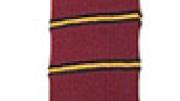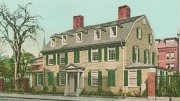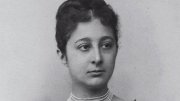Ordinarily, a Harvard College class necktie is crimson emblazoned with one’s class numerals and often the shield of the University. On the lookout for—and spotting—deviant ties sported by some older alumni at Commencement in June, Warren M. “Renny” Little ’55, of Cambridge, asked these graduates whether they knew why their neckties had narrow stripes of Dartmouth green, or Princeton orange and black, or Yale blue within the predominant crimson. The old boys he queried were clueless. Most class secretaries from the 1930s and 1940s interviewed by Little were also in the dark about class colors. Two banners hanging from Yard windows at Commencement marked the hospitality suites of the classes of ’49 and Little’s own ’55. “I’m sure people wondered,” he says, “why the banners were blue.”
In a rowing race in 1882, according to the Crimson, the freshman crew wore crimson, and to distinguish themselves the senior crew wore green and white, the juniors blue and white, and the sophomores orange and white, which evolved to orange and black on future occasions. (Why choose colors of rival colleges, instead of, say, mauve, fuchsia, and puce? Preppies stick together?) Little believes that this means of identifying class crews may have led to the adoption of class colors. A custom then arose in which the senior class passed their color with ceremony to the freshmen on Class Day of Commencement week.
In 1904, seniors began to buy and wear class buttons—blue ones that year. The purpose of buttons for a class, reported the Crimson, was “to further acquaintance among its members.” Freshmen gained the right to button up in 1911. Sophomores and juniors toyed with the idea of wearing such insignia, but that suggestion stirred up controversy. The Student Council voted in 1913 that buttons would be solely a senior prerogative.
So keen was button enthusiasm that the Button Committee of the class of ’12 considered 59 designs for a green senior button submitted by 18 competitors. “A senior class button is a little thing,” noted the Crimson, “but it can do a lot for Class Unity.”
But the fashion faded. “The class of 1918,” says Little, “appears to be the last to institute a class button.” Still, the seniors continued with pomp to pass on their color at Class Day through 1963, when they gave green to the rising sophomores of ’66, the last class to be presented a color.
Little looked into the history of class colors, with help from Justin Lanning ’12, of Pforzheimer House and Encinitas, California, at the request of the Freshman Dean’s Office. Panty raids on Radcliffe or a Freshman Smoker being no longer quite the thing, as Little observes, officials were poking around for lapsed traditions that might be revived at the first-ever convocation for freshmen, scheduled for September 1 (see "A Freshman Tradition Begins"). In the event, this new class of ’13 was not assigned a color (it would have been orange and black), but they could learn of this tradition in the convocation program. Who knows what action they may take in the future?
Though this year’s freshmen got no color, “Classes still have the right to them, theologically speaking,” claims the Reverend Doctor Timothy B. Cogan ’56, of Edgartown, Massachusetts, whose color is orange and black (as was his father’s), in a letter to Little. Class colors should not be forgotten, Cogan avers, “even if they exist primarily in a theoretical way. Isn’t it just as easy to proclaim that they have ‘always been and always will be’? The only real shame would be in claiming that they no longer exist. That would be heresy, I think.”
Threads. Harvard’s decision to license the use of its name to Wearwolf Group, a maker of designer clothing, received widespread attention in August from the press, comedians, and fashionistas, although the University has exploited its name on clothing since the presidency of Derek Bok, with the proceeds going to student aid. The “Harvard Yard” clothing line, said to aspire to a preppy look reminiscent of the Sixties, will feature trousers starting at $195, shirts at $160 and up, and sportcoats for $495. The word “Harvard” will appear only on the labels inside, and other references to the University, the designer promises, will be minute, such as crimson stitching on the buttonholes. Crimson’s fine, but how about the odd buttonhole in green, orange and black, or blue—for a touch of class?









